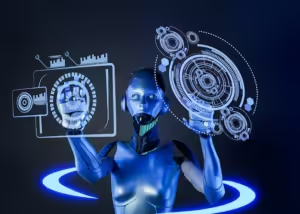Introduction
Augmented Reality (AR) stands at the forefront of transformative technologies, offering users an immersive and interactive experience by overlaying digital content onto the real world. With the integration of Artificial Intelligence (AI), AR experiences are poised to reach unprecedented levels of sophistication and realism. This fusion of AI and AR holds the potential to revolutionize various industries, from education and healthcare to entertainment and beyond.
A. Definition of Augmented Reality (AR)
Augmented Reality refers to the technology that superimposes digital information such as images, videos, or 3D models onto the user’s view of the physical world, typically through the lens of a smartphone, tablet, or specialized AR glasses. Unlike Virtual Reality (VR), which replaces the real world with a simulated environment, AR enhances the real world by adding virtual elements, enriching the user’s perception and interaction with their surroundings.
B. Overview of AI integration in AR
The integration of AI technologies such as Machine Learning, Computer Vision, and Natural Language Processing into AR systems enhances their capabilities to perceive, understand, and interact with the environment in real time. AI algorithms empower AR devices to recognize objects, interpret scenes, and respond intelligently to user input, thereby creating more immersive and personalized experiences.
C. Importance of enhancing immersive experiences
Enhancing immersive experiences in AR goes beyond mere entertainment; it holds significant implications for education, training, healthcare, and various other domains. By leveraging AI-driven intelligent overlays, AR can provide users with valuable information, guidance, and assistance tailored to their specific needs and preferences. This not only enhances user engagement but also enables more effective learning, decision-making, and problem-solving in diverse contexts.
In the subsequent sections, we delve deeper into the foundations of AI in Augmented Reality and explore how intelligent overlays can enhance immersive experiences, followed by a discussion on applications, challenges, and future directions of this synergistic convergence.
Foundations of AI in Augmented Reality
Augmented Reality (AR) relies on a sophisticated interplay of various Artificial Intelligence (AI) technologies to deliver seamless and immersive experiences. These foundational AI elements form the backbone of AR systems, enabling them to perceive, understand, and interact with the real-world environment in real time.
A. Machine Learning algorithms in AR
Machine Learning (ML) algorithms play a pivotal role in AR by enabling devices to learn from data and adapt their behavior accordingly. In AR applications, ML algorithms are employed for tasks such as object recognition, gesture detection, and semantic segmentation. By continuously analyzing and processing visual and spatial data, ML algorithms enhance the accuracy and robustness of AR experiences, allowing for more precise object placement, occlusion handling, and scene understanding.
B. Computer Vision and AR
Computer Vision (CV) forms the core of many AR systems, empowering devices to perceive and interpret visual information from the surrounding environment. CV techniques such as feature detection, image registration, and depth estimation enable AR devices to accurately track objects, understand spatial relationships, and overlay virtual content seamlessly onto the real world. Through CV, AR experiences become more immersive and interactive, as users can interact with virtual objects as if they were part of the physical environment.
C. Natural Language Processing (NLP) in AR
Natural Language Processing (NLP) plays a crucial role in enabling natural and intuitive interaction between users and AR systems. By processing and understanding human language inputs, NLP algorithms enable AR devices to respond to voice commands, recognize speech, and generate contextually relevant information. In AR applications, NLP facilitates tasks such as speech-based navigation, voice-controlled interfaces, and conversational agents, enhancing user engagement and accessibility.
The integration of Machine Learning, Computer Vision, and Natural Language Processing forms the foundation of AI in Augmented Reality, enabling devices to perceive, understand, and respond intelligently to the real-world environment. In the following section, we explore how these intelligent overlays enhance immersive experiences in AR, ushering in a new era of interactive and personalized interactions.
Intelligent Overlay Technologies
Intelligent overlay technologies represent the convergence of Artificial Intelligence (AI) and Augmented Reality (AR), enabling AR systems to dynamically superimpose digital content onto the real-world environment in a contextually relevant and interactive manner. These technologies leverage advanced algorithms and sensory data to recognize objects, understand scenes, and augment the user’s perception and interaction with their surroundings.
A. Object recognition and tracking
Object recognition and tracking are fundamental capabilities of intelligent overlay technologies, allowing AR systems to identify and locate physical objects in the user’s environment. Through techniques such as feature extraction, pattern recognition, and deep learning, AR devices can accurately detect and track objects in real time, enabling seamless integration of virtual content with the physical world. Whether it’s recognizing everyday objects, landmarks, or specific items, object recognition and tracking enhance the realism and interactivity of AR experiences, opening up a wide range of applications across industries.
B. Scene understanding and context awareness
Scene understanding and context awareness enable AR systems to interpret the spatial layout and semantic context of the user’s environment, facilitating more immersive and adaptive experiences. By analyzing visual and spatial cues, AR devices can infer the user’s location, surroundings, and intent, allowing them to dynamically adjust virtual content based on contextual factors such as lighting conditions, user movement, and environmental obstacles. This contextual awareness enhances the relevance and usability of AR overlays, making them more responsive and intuitive to user needs and preferences.
C. Gesture and motion tracking
Gesture and motion tracking technologies enable users to interact with AR content using natural hand gestures and body movements, enhancing the sense of immersion and control. By leveraging depth-sensing cameras, motion sensors, and machine learning algorithms, AR devices can accurately track and interpret user gestures in real time, enabling intuitive manipulation of virtual objects, navigation through digital interfaces, and spatial interactions within the AR environment. Gesture and motion tracking empower users to engage with AR content more intuitively and expressively, fostering deeper immersion and user engagement.
Intelligent overlay technologies, encompassing object recognition and tracking, scene understanding and context awareness, and gesture and motion tracking, form the backbone of AI-driven Augmented Reality experiences. These technologies enable AR systems to dynamically integrate digital content with the physical world, creating immersive, interactive, and contextually relevant experiences for users. In the subsequent section, we explore how these intelligent overlays enhance immersive experiences in AR across various applications and domains.
Enhancing Immersive Experiences
Augmented Reality (AR) has the potential to redefine the way users perceive and interact with their surroundings, offering immersive experiences that seamlessly blend the physical and digital worlds. By leveraging intelligent overlay technologies powered by Artificial Intelligence (AI), AR systems can enhance immersion by providing personalized, interactive, and contextually relevant content tailored to the user’s needs and preferences.
A. Personalization and adaptive content
One of the key ways in which AI enhances immersive experiences in AR is through personalization and adaptive content delivery. By analyzing user preferences, behavior patterns, and contextual cues, AI algorithms can tailor AR content to match the user’s interests, skill level, and situational context. Whether it’s recommending relevant information, adjusting the difficulty level of interactive tasks, or customizing virtual objects based on user preferences, personalized AR experiences create a deeper sense of engagement and relevance for the user.
B. Real-time interaction and feedback
AI-driven AR systems enable real-time interaction and feedback, allowing users to dynamically engage with virtual content and receive immediate responses based on their actions. Through techniques such as natural language processing, gesture recognition, and spatial tracking, AR devices can interpret user input in real time, enabling intuitive interactions with virtual objects, characters, and interfaces. Real-time feedback mechanisms such as haptic feedback, audio cues, and visual indicators further enhance the user’s sense of immersion and agency within the AR environment, fostering a more responsive and engaging user experience.
C. Gamification and storytelling
Gamification and storytelling techniques are increasingly being integrated into AI-driven AR experiences to enhance immersion and engagement. By leveraging game mechanics such as points, rewards, challenges, and progression systems, AR applications can transform everyday tasks into engaging and rewarding experiences. Whether it’s learning new skills through interactive tutorials, exploring virtual worlds through interactive narratives, or collaborating with others in multiplayer games, gamified AR experiences captivate users’ attention and motivate them to actively participate in the experience.
Enhancing immersive experiences in AR through personalization, real-time interaction, and gamification not only increases user engagement but also enables more effective learning, training, and entertainment experiences. By leveraging the capabilities of AI-driven intelligent overlay technologies, AR systems can create rich, dynamic, and personalized experiences that blur the boundaries between the physical and digital worlds, opening up new possibilities for creativity, exploration, and collaboration.
Applications of AI in Augmented Reality
The integration of Artificial Intelligence (AI) technologies into Augmented Reality (AR) systems has unlocked a myriad of innovative applications across various industries and domains. By leveraging intelligent overlay technologies, AI-driven AR experiences are transforming how users interact with the world around them, enabling new forms of education, healthcare, entertainment, and beyond.
A. Education and Training
AI-powered AR applications are revolutionizing education and training by providing immersive and interactive learning experiences. In the classroom, AR-enhanced textbooks and educational apps overlay digital content such as 3D models, animations, and simulations onto physical objects, bringing abstract concepts to life and enhancing students’ understanding of complex subjects. In vocational training and professional development, AR enables hands-on learning experiences, allowing trainees to practice skills in simulated environments and receive real-time feedback based on their performance.
B. Healthcare and Medical Assistance
In the healthcare industry, AI-driven AR solutions are empowering medical professionals with advanced visualization tools, diagnostic aids, and surgical guidance systems. AR-enabled medical devices, such as smart glasses and augmented reality headsets, overlay patient data, medical images, and real-time physiological information onto the clinician’s field of view, enhancing situational awareness and decision-making during surgeries, medical procedures, and patient consultations. Additionally, AR-based training simulations help medical students and practitioners refine their skills and gain hands-on experience in a risk-free environment.
C. Entertainment and Gaming
AI-enhanced AR experiences are reshaping the landscape of entertainment and gaming, offering users immersive and interactive entertainment experiences. In the gaming industry, AR games blur the lines between the virtual and physical worlds, allowing players to engage with digital characters and environments overlaid with their real-world surroundings. From location-based AR games that encourage exploration and social interaction to immersive storytelling experiences that unfold in the user’s environment, AI-driven AR gaming experiences offer new levels of immersion, creativity, and engagement.
D. Retail and Commerce
AI-powered AR applications are transforming the retail and commerce landscape by revolutionizing the way consumers discover, explore, and purchase products. AR-enabled shopping experiences allow users to visualize products in their own space, try on virtual clothing and accessories, and preview furniture and home decor items before making a purchase. AI algorithms analyze user preferences, purchase history, and contextual data to personalize product recommendations and enhance the shopping experience, leading to increased customer satisfaction and conversion rates.
E. Architecture and Design
In architecture and design, AI-driven AR solutions facilitate the visualization, collaboration, and decision-making processes throughout the design and construction phases. AR-enabled design tools overlay architectural plans, 3D models, and building simulations onto physical spaces, enabling architects, engineers, and clients to visualize and evaluate design concepts in real-world contexts. AI algorithms analyze building data, environmental factors, and user feedback to optimize design decisions, improve project efficiency, and reduce errors during construction.
From education and healthcare to entertainment and retail, the applications of AI in Augmented Reality are diverse and far-reaching, offering transformative opportunities to enhance productivity, creativity, and user experiences across various industries and domains. As AI continues to advance and AR technologies become more accessible, we can expect to see even more innovative applications that push the boundaries of what’s possible in the realm of augmented reality.
Applications of AI in Augmented Reality
The fusion of Artificial Intelligence (AI) with Augmented Reality (AR) technology has given rise to a plethora of innovative applications across numerous sectors. These applications harness the power of intelligent overlay technologies to create immersive, interactive, and context-aware experiences that enhance productivity, creativity, and engagement in various domains.
A. Education and Training
AI-powered AR is revolutionizing education and training by providing immersive and interactive learning experiences. AR-enhanced textbooks, educational apps, and simulation tools overlay digital content onto physical objects, making abstract concepts tangible and fostering deeper understanding. Students can engage in interactive experiments, explore historical events in 3D, or dissect virtual organisms, facilitating active learning and knowledge retention. In professional training, AR enables hands-on simulations for tasks ranging from medical procedures to equipment maintenance, offering a safe and cost-effective way to practice real-world skills.
B. Healthcare and Medical Assistance
In healthcare, AI-driven AR applications are enhancing diagnosis, treatment, and patient care. Surgeons can use AR overlays to visualize patient anatomy in real-time during surgeries, improving precision and reducing risks. AR-guided medical imaging helps clinicians interpret complex scans and identify abnormalities more accurately. Patients benefit from AR-assisted rehabilitation exercises and medication adherence reminders delivered through wearable AR devices. Furthermore, AR simulations aid medical education and training, allowing students to practice procedures in realistic virtual environments.
C. Entertainment and Gaming
AI-enhanced AR experiences are transforming entertainment and gaming, blurring the lines between the virtual and physical worlds. Location-based AR games encourage exploration and social interaction by overlaying game elements onto real-world locations. Immersive storytelling experiences unfold in the user’s environment, offering interactive narratives that respond to user actions and choices. AR gaming experiences leverage AI algorithms to adapt gameplay based on player behavior, creating dynamic and engaging experiences tailored to individual preferences.
D. Retail and Commerce
In retail, AI-powered AR applications are revolutionizing the shopping experience by enabling virtual try-ons, product visualization, and personalized recommendations. Customers can use AR apps to visualize furniture in their homes before making a purchase or try on virtual clothing using augmented reality mirrors. AI algorithms analyze user preferences and shopping behavior to provide personalized product recommendations and enhance the overall shopping experience. Retailers benefit from increased customer engagement, reduced returns, and improved conversion rates.
E. Architecture and Design
AI-driven AR solutions are transforming architecture and design processes by enabling visualization, collaboration, and decision-making in real-world contexts. Architects and designers can use AR to overlay digital models onto physical spaces, allowing clients to experience and provide feedback on proposed designs in real time. AI algorithms analyze building data and environmental factors to optimize design decisions and improve energy efficiency. AR-enhanced design tools facilitate collaboration among team members, enabling seamless communication and iteration throughout the design process.
From education and healthcare to entertainment, retail, and architecture, the applications of AI in Augmented Reality are diverse and impactful. By leveraging intelligent overlay technologies, these applications unlock new opportunities to enhance productivity, creativity, and user experiences across a wide range of industries and domains. As AI and AR continue to advance, we can expect to see even more innovative applications that push the boundaries of what’s possible in augmented reality.
Conclusion
The convergence of Artificial Intelligence (AI) and Augmented Reality (AR) has ushered in a new era of transformative experiences, offering immersive, interactive, and contextually rich environments across various sectors. As we’ve explored the applications and implications of AI in AR, it’s evident that this synergistic combination holds tremendous potential to revolutionize education, healthcare, entertainment, retail, architecture, and beyond.
By harnessing the power of intelligent overlay technologies, AI-driven AR experiences can enhance productivity, creativity, and engagement in unprecedented ways. From personalized learning experiences and augmented medical procedures to immersive gaming adventures and interactive shopping journeys, the applications of AI in AR are diverse and far-reaching.
Moreover, AI-driven AR solutions have the potential to address complex challenges and improve outcomes in areas such as education, healthcare, and environmental sustainability. By leveraging AI algorithms to analyze data, optimize processes, and provide real-time insights, AR systems can empower users to make better decisions, solve problems more effectively, and navigate the complexities of the modern world with greater confidence.
However, as we embrace the opportunities afforded by AI in AR, it’s essential to remain mindful of ethical considerations, privacy concerns, and the need for responsible innovation. As AI-powered AR experiences become increasingly integrated into our daily lives, it’s imperative to prioritize transparency, accountability, and inclusivity to ensure that these technologies benefit society as a whole.
In conclusion, the fusion of AI and AR represents a paradigm shift in how we perceive, interact with, and experience the world around us. By continuing to explore, innovate, and collaborate, we can unlock the full potential of AI-driven AR experiences to create a future where immersive, intelligent, and empowering interactions enrich our lives in ways we have yet to imagine.












